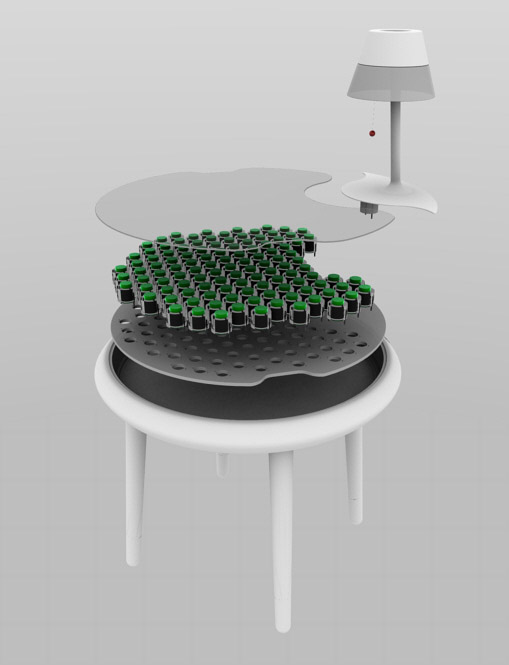INHALE is a cultural platform where artists are presented, where great projects are given credit and readers find inspiration. Think about Inhale as if it were a map: we can help you discover which are the must-see events all over the world, what is happening now in the artistic and cultural world as well as guide you through the latest designers’ products. Inhale interconnects domains that you are interested in, so that you will know all the events, places, galleries, studios that are a must-see. We have a 360 degree overview on art and culture and a passion to share.

Biophotovoltaic - MOSS TABLE
The Moss Table is a conceptual design intended to demonstrate the potential of Biophotovoltaic technology and how it might be applied in the future. Biophotovoltaic (BPV) devices generate renewable energy and other useful by-products from the photosynthesis of living organisms such as algae and moss. The Moss Table suggests a future in which hybrid natural/artificial objects are utilised in the home.
The design of the table was kept deliberately simple so as not to draw attention away from the moss and the technology. The silhouette of the Moss Table echoes that of a simple table and lamp, whilst the soft curves and neutral colour help to focus attention on the beautiful moss.
Biophotovoltaic technology is at a very early stage of development. Moss can be used to power small electronic devices like a digital alarm clock, but cannot currently power the table’s integrated lamp. However scientists anticipate that with further research, applications like this may be feasible.
The moss table has been designed in the University of Cambridge by Carlos Peralta and Alex Driver in collaboration with scientist Paolo Bombelli who has been responsible for its scientific development.
Research into Biophotovoltaics involves collaboration between the departments of Chemical Engineering and Biotechnology, Biochemistry and Plant Sciences at Cambridge University, and the Chemistry department at Bath University. The research is jointly led by Doctor Adrian Fisher, Professor Christopher Howe and Professor Alison Smith in Cambridge, and Doctor Petra Cameron in Bath. This research project is funded by the Engineering and Physical Sciences Research Council (EPSRC).
The Moss Table is an output a research project called Design in Science, which is funded by the EPSRC and led by Dr James Moultrie of Cambridge University’s Institute for Manufacturing. Its aim is to explore how designers can play a role in early stage scientific research.
Fabienne Felder – MOSS FM
Moss FM is the world’s first plant-powered radio, and the first working moss-powered object requiring more electricity than an LCD. It makes use of an emerging biophilic technology: Photo Microbial Fuel Cells (Photo-MFCs). Electrons and protons produced by photosynthesising plants are harnessed and transformed into electrical current.
Photo-MFCs make use of a biochemical process and are still at an experimental stage, which are both reflected in the design of the radio. It can currently run for a few minutes via a battery that is charged soley by moss.
Low-powered gadgets, such as the LCD screen shown below, run continuously hooked to a capacitor or directly to the serial circuit of moss pots.
Fabienne Felder, 2013, in collaboration with Dr. Paolo Bombelli, University of Cambridge.
via biophotovoltaics.wordpress.com, fabiennefelder.prosite.com
































































